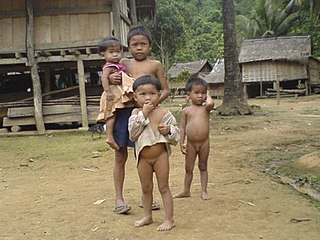Religion
| | This section is empty. You can help by adding to it. (February 2022) |
| Total population | |
|---|---|
| 27,893 (est.) | |
| Regions with significant populations | |
| Laos, Thailand, United States | |
| Languages | |
| Mal, Lao, Thai, others | |
| Religion | |
| Theravada Buddhism |
The Mal are an ethnic group native to Laos and Thailand. They are one of two sub-groups of the Lua people (the other one being the Phai). [1]
The Mal are also commonly referred to as Madl, Khatin, T'in, Htin, Thin, and Tin. [2]
The Mal speak a language also called Mal, which is a Khmuic language. [2] The Khmuic languages are Austroasiatic. [2]
| | This section is empty. You can help by adding to it. (February 2022) |
The Ơ Đu (O'du) are an aboriginal ethnic group in Vietnam and Laos. Their total population is more than 570.
Khmu[kʰmuʔ] is the language of the Khmu people of the northern Laos region. It is also spoken in adjacent areas of Vietnam, Thailand and China. Khmu lends its name to the Khmuic branch of the Austroasiatic language family, the latter of which also includes Khmer and Vietnamese. Within Austroasiatic, Khmu is often cited as being most closely related to the Palaungic and Khasic languages. The name "Khmu" can also be seen romanized as Kmhmu, Khmu', Kammu, or Khamuk in various publications or alternatively referred to by the name of a local dialect.

The Khmu are an ethnic group of Southeast Asia. The majority (88%) live in northern Laos where they constitute the largest minority ethnic group, comprising eleven percent of the total population. Alternative historical English spellings include Kmhmu, Kemu and Khammu, among others.

The Khmuic languages are a branch of the Austroasiatic languages spoken mostly in northern Laos, as well as in neighboring northern Vietnam and southern Yunnan, China. Khmu is the only language in the group that has many speakers.

The Mlabri or Mrabri are an ethnic group of Thailand and Laos, and have been called "the most interesting and least understood people in Southeast Asia". Only about 400 or fewer Mlabris remain in the world today, with some estimates as low as 100. A hill tribe in northern Thailand along the border with Laos, they have been groups of nomadic hunter-gatherers. Those in Thailand live close to the Hmong and northern Thai. Those living in Laos live close to other ethnic groups.
Mlabri is a language spoken by the Mlabri people in the border area between Thailand and Laos.
Phong, also known as Kniang, is an Austroasiatic language of the Mon–Khmer family, spoken in Laos. Its nearest relatives are the fellow Xinh Mul tongues, the Khang language and Puoc language, both spoken in Vietnam. The number of speakers of Phong-Kniang is estimated at 30,700.
The Mang are an ethnic group living primarily in Lai Châu, northwestern Vietnam, where they are one of that nation's 54 officially recognized ethnic groups. There are also about 500 Mang living in the Yunnan province of southern China, where they are officially termed an undistinguished nationality.

The Lua people are a minority ethnic group native to Laos, although there is now a sizable community living in Thailand. Lua' is their preferred autonym (self-designation), while their Lao neighbours tend to call them Thin, T'in or Htin. Another term for this group is Lawa. There are two subgroups: the Mal and the Phai or Pray.
The Phai are an ethnic group in Thailand and Laos. They are one of two sub-groups of the Lua people.
The Ksingmul, also known as Con Pua, Puộc, and Pụa, are an ethnic group in Vietnam and Laos. In Vietnam, they live primarily in the northwest, in the provinces of Sơn La and Lai Châu. The group numbers approximately 29,503 people and its language is in the Khmuic languages group of the Mon–Khmer language family.

Khmuic peoples refers to a group of ethnic groups of Southeast Asia.
The Lamet people are an ethnic group in Thailand and Laos.
Alak is a language spoken by some 4,000 people in southern Laos, especially in the Provinces of Salavan and Sekong. It is closely related to the language spoken by the Bahnars of Vietnam. It includes two dialects, Alak proper and Harak.
The Alak or Hrlak are an Austroasiatic ethnic group of southern Laos, living mainly in Salavan Province. They speak the Alak language. Little is known of their history, though as an Austroasiatic-speaking group, their origin is presumably in the Central Highlands of Vietnam.
Lamet is a Mon–Khmer language of Laos. There are also one hundred speakers in Lampang Province, Thailand, where it is known as Khamet. Lamet speakers call their language [χəmɛːt], or less commonly [kʰəmɛːt].
Kháng, also known as Mang U’, is an Austroasiatic language of Vietnam. It is closely related to the Bumang language of southern Yunnan, China.
Nyaheun is a Mon–Khmer language of the Bahnaric branch spoken in southern Laos. Chazée (1999:95) estimates the population at 4,200, while the 1995 Laotian census places the Nyaheun population at 5,152. According to Ethnologue, the language is "vigorous," which means it is spoken by people of all ages in its home community. The same source says the 2015 census puts the population at 9,000 https://www.ethnologue.com/language/nev
Oʼdu, or Iduh, is a Mon–Khmer language of Vietnam and Laos. Once spoken by about 300 people in Tương Dương district, Nghệ An province, Vietnam, it is now considered to be almost extinct.
Mal, also known as Thin, is a Mon–Khmer language of Laos and Thailand. It is one of several closely related languages which go by the names Thin or Prai.